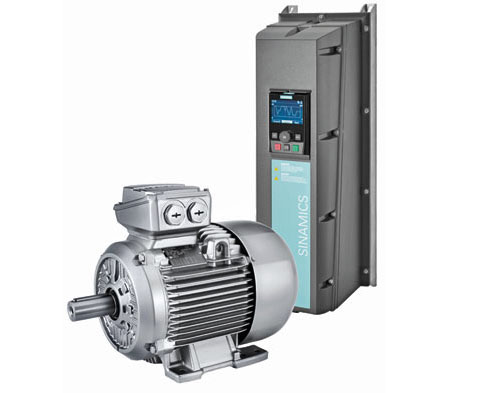Energy costs are sneaking up. At my house electricity now costs $0.165 for a KWh. I believe that was only $0.11/Kwh a couple of years ago. Along with that, manufacturing plants continue to add more automation and more electric motors. For standard 50/60 Hz AC induction motors there has been a path for better efficiency – and less use of expensive electricity.
In the 1990s upgrading to EPAct motors yielded as many as four percentage points efficiency over the old “standard-efficiency” motors. Later, manufacturing companies began installing NEMA Premium motors, which are one to two percentage points more efficient than EPAct motors. Now IEEE Plus takes another step up.
One design approach from Siemens
Siemens has the IEEE Plus models that feature die-cast copper rotors and other design improvements that make them one or two percentage points more efficient than current NEMA Premium motors.
The SIMOTICS SD IEEE 841 severe duty motors are used in plants that are dusty or contain chemically aggressive environments (Figure 1) and have a power range of 0.09 to 200 kW. They can be optimized for line or frequency converter operation. One application example handles Wollastonite – a non-toxic material and an accepted replacement for asbestos. But, like any mineral particulate, it can damage equipment, including motors. IEEE 841 describes tightly sealed (TEFC or non-ventilated) motors that are designed to guard against such environments. These motors typically also meet or exceed NEMA Premium efficiency standards.

About two-thirds of an AC induction motor’s electrical losses occur in the stator, and motor manufacturers have made great strides in reducing these losses by adding more copper to the stator windings, thus reducing wasteful I2 R heating. NEMA Premium-grade motors are largely based on this practice. Meanwhile, rotor losses account for about 25% of the total. These losses occur in three forms: slip losses, magnetic core losses and, again, I2 R losses in the rotor’s conductor bars. John Caroff, marketing manager, low-voltage motors at Siemens Energy & Automation, explains that the motors’ very high efficiency results from their die-cast copper rotors, combined with a careful redesign of the entire motor to optimize the properties brought by copper and stringent quality control during manufacturing to minimize electrical and stray-load losses. Substituting die-cast copper for traditional die-cast aluminum in the “squirrel cage” decreases resistive losses because copper’s volumetric electrical conductivity is approximately 66% higher than that of aluminum. Copper provides other benefits, as well, including the ability to shorten the lamination stack (thus reducing cost) and, depending on design, reduce slip.
Siemens ultra-efficient motors are available in general-purpose TEFC and IEEE 841 (Severe Duty) configurations in sizes up to 20 hp.
In the European Union, wide ranging legislation has been ratified with the objective to reduce energy usage and in turn CO 2 emissions. EU Regulation 640/2009 and the supplement 04/2014 involve energy usage and/or the energy efficiency of induction motors in the industrial environment. In the meantime, this regulation is valid in all countries belonging to the European Union.
The standard IEC 60034-30-1:2014 defines efficiency classes for 50 and 60 Hz and stipulates, worldwide, which motors are involved and which exceptions apply. The EU Regulation is essentially based on this standard.
New efficiency classes have been defined in IEC 60034-30-1 for induction motors:
IE1 Standard Efficiency
IE2 High Efficiency
IE3 Premium Efficiency
IE4 Super Premium Efficiency

Figure 2: Efficiency classes IE1-IE4 according IEC 60034-30-1
Baldor premium efficient motor
One example of a premium efficient motor would be the CEM2394T from Baldor. It has a heavy gauge steel and cast iron frame, ball bearings, ISR (Inverter Spike Resistant) copper windings, low-loss electrical grade lamination steel, and a three year warranty.

Typical applications include operations where continuous or frequent duty is required. Super-E Motors are uitable for variable torque applications and constant torque speed range with properly sized and adjusted variable frequency drives.
This particular model provides 15 hp using 38 A at 208 V, three phase, with 91% efficiency. RPM is 3520 and service factor is 1.15. It weighs a hefty 250 lbs.
A brush type DC motor from Crouzet
A different type of motor comes from Crouzet Motors. Their DCmind brush motor series with 15, 25 and 55 W units that have a 42 mm diameter, and 55 and 104 W motors with a 63 mm diameter. They support 12, 24, and 48 volt power supplies and are available with several accessories and adaptations, including rear brake, optical or Hall effect encoders.

These motors feature exceptionally quiet operation of only 35 dBA (about the sound of a whispered conversation). They are designed with a high performance magnetic circuit and magnets that optimize detent torque and provide 80% operational efficiency with an extended service life up to 24,000 hours. The motors meet several standards in applications for medical (IEC 60601-1), office equipment (IEC 60950), and household appliances (IEC 60335). They are approved in accordance with UL 10004-1 and CE, and are RoHS compliant.
Advertisement
Learn more about Electronic Products Magazine





